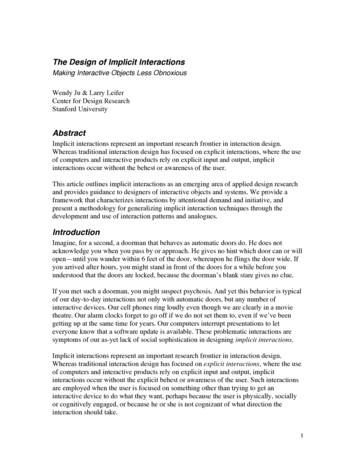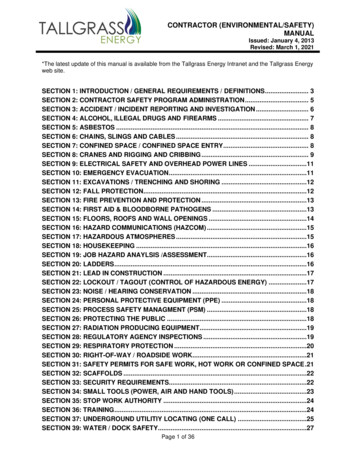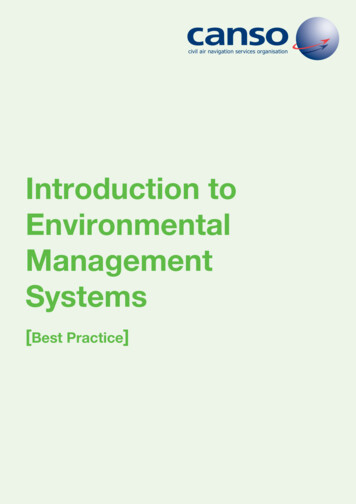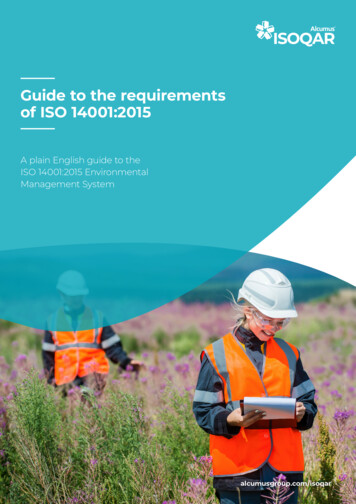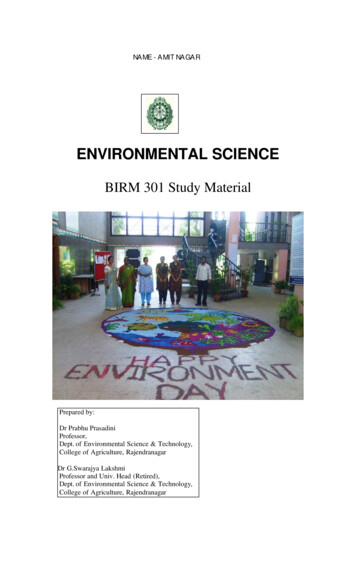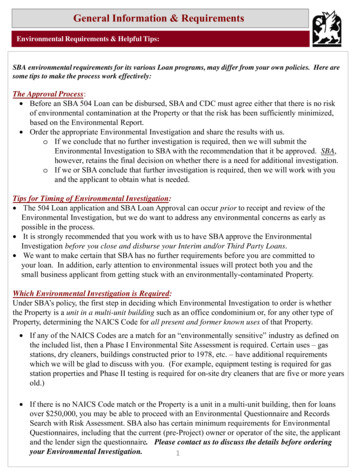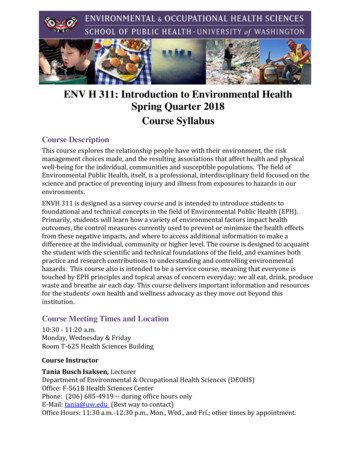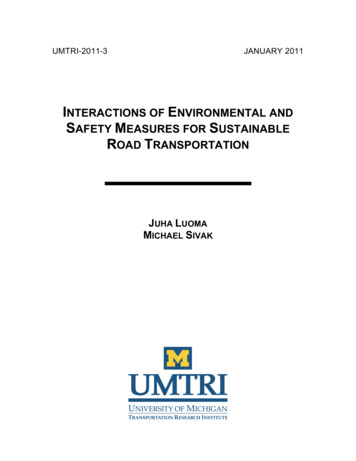
Transcription
UMTRI-2011-3JANUARY 2011INTERACTIONS OF ENVIRONMENTAL ANDSAFETY MEASURES FOR SUSTAINABLEROAD TRANSPORTATIONJUHA LUOMAMICHAEL SIVAK
INTERACTIONS OF ENVIRONMENTAL AND SAFETYMEASURES FOR SUSTAINABLE ROAD TRANSPORTATIONJuha LuomaMichael SivakThe University of MichiganTransportation Research InstituteAnn Arbor, Michigan 48109-2150U.S.A.Report No. UMTRI-2011-3January 2011
Technical Report Documentation Page1. Report No.2. Government Accession No.3. Recipient s Catalog No.UMTRI-2011-34. Title and Subtitle5. Report DateInteractions of Environmental and Safety Measures forSustainable Road TransportationJanuary 20116. Performing Organization Code3838187. Author(s)8. Performing Organization Report No.Juha Luoma and Michael SivakUMTRI-2011-39. Performing Organization Name and Address10. Work Unit no. (TRAIS)The University of MichiganTransportation Research Institute2901 Baxter RoadAnn Arbor, Michigan 48109-2150 U.S.A.11. Contract or Grant No.12. Sponsoring Agency Name and Address13. Type of Report and Period CoveredThe University of MichiganSustainable Worldwide TransportationandVTT Technical Research Centre of FinlandTraffic Safety 202514. Sponsoring Agency Code15. Supplementary NotesThe current members of Sustainable Worldwide Transportation include Autoliv Electronics,Bosch, FIA Foundation for the Automobile and Society, General Motors, Honda R&DAmericas, Meritor WABCO, Nissan Technical Center North America, Renault, and ToyotaMotor Engineering and Manufacturing North America. Information about SustainableWorldwide Transportation is available at http://www.umich.edu/ umtriswt.The current members of Traffic Safety 2025 include A-Katsastus Group, Finnish TransportAgency, Finnish Transport Safety Agency, Nokian Tyres, VR-Group, and VTT. Informationabout Traffic Safety 2025 is available at http://www.vtt.fi/proj/tl2025.16. AbstractThis study examined interactions of environmental and safety measures for roadtransportation. The results showed that a vast majority of the examined measures supportboth policy objectives and thereby contribute effectively to sustainable transportation.However, there were also measures with conflicting effects, although the number of thosemeasures was limited. In addition, there were a number of measures with no interaction.Furthermore, many potential effects were not documented and therefore in many instancesonly likely effects were noted.There are two practical implications of this study. First, those measures that result indouble benefits should be encouraged to be implemented. Second, in case of conflictingmeasures, the specific implementations should attempt to minimize the negative effects.17. Key Words18. Distribution Statementenvironment, safety, road transportation, measuresUnlimited19. Security Classification (of this report)20. Security Classification (of this page)NoneNone21. No. of Pages32i22. Price
.umich.edu/ umtriswt).bySustainableWorldwideTransportationThe current members of this research consortium areAutoliv Electronics, Bosch, FIA Foundation for the Automobile and Society, General Motors,Honda R&D Americas, Meritor WABCO, Nissan Technical Center North America, Renault, andToyota Motor Engineering and Manufacturing North America.Additional support for this research was provided by Traffic Safety 2025(http://www.vtt.fi/proj/tl2025), a Finnish research program led by VTT Technical ResearchCentre of Finland. The current members of this research consortium are A-Katsastus Group,Finnish Transport Agency, Finnish Transport Safety Agency, Nokian Tyres, VR-Group, andVTT.Juha Luoma’s contribution was prepared while he was a visiting research scientist atUMTRI from the VTT Technical Research Centre of Finland (http://www.vtt.fi).The authors wish to thank Veli-Pekka Kallberg (VTT), Kari Mäkelä (VTT), and BrandonSchoettle (UMTRI) for their helpful suggestions on earlier drafts of this report.ii
ContentsAcknowledgments. ii Introduction. 1 Approach. 2 Effects of environmental measures on road safety . 3 Effects of road-safety measures on the environment. 10 Summary of the analyses . 19 Discussion . 21 References. 23 iii
IntroductionRoad transportation has positive effects on the economy, but negative effects onsafety and the environment. The magnitude of the road-safety problem worldwide hasbeen recognized for decades (e.g., Peden, Scurfield, Sleet, Mohan, Hyder, Jarawan, andMathers, 2004). Similarly, many environmental effects of road transportation have beendiscussed for a long time. However, the recent discussion of climate change has broughtto the forefront the need to significantly curb greenhouse gas (GHG) emissions producedby road transportation.Current transportation is predominantly based on the combustion of fossil fuels,making it one of the largest sources of air pollution and greenhouse gases (UnitedNations, 2010). Furthermore, transportation is the cause of other environmental effects,such as noise pollution and the loss of land and open space. However, the movement ofgoods and people is crucial for social and economic development; it enables trade andprovides opportunities for employment, education, and leisure. Consequently, there is aneed for sustainable mobility.To meet the environmental and safety challenges of road transportation, a numberof measures have been designed and implemented. This raises the issue of interactionsbetween those two types of measures (e.g., Noland, 2009). Of specific interest are theimpacts of current environmental measures on road safety, and the impacts of currentroad-safety measures on the environment.This study was designed to examine potential interactions of environmental andsafety measures for road transportation. A variety of potential interactions can occur.Some measures can be beneficial for both environmental and safety targets, some of themcan conflict, or some may result in no interaction. It is important to identify measuresthat result in double benefits, because they represent effective sustainable-transportationmeasures. The identification of conflicting measures is important as well, because itwould help assess the total benefits of a given measure.1
ApproachThis study reviewed road-safety effects of various measures targetingenvironmental problems of road transportation, and environmental effects of variousroad-safety measures. Three recent documents were used as the main sources for theselection of measures: EPA Analysis of the Transportation Sector: Greenhouse Gas andOil Reduction Scenarios (EPA, 2010), Greenhouse Gas Reduction Strategies in theTransport Sector: Preliminary Report (OECD/ITF, 2008), and The Handbook of RoadSafety Measures (Elvik, Høye, Vaa, and Sørensen, 2009). In addition to the selection ofsafety measures, the book by Elvik et al. (2009) provided a principal source for theselection of environmental effects of road-safety measures.The study was limited to documented measures that have been used or will likelybe used in the near future. The focus of the study was on road transportation. However,some measures dealing with modal split can influence other transportation modes as well.The magnitude of the effectiveness of the measures was not dealt with.The covered environmental measures focused on air pollution and greenhousegases. (Carbon dioxide is not considered an air pollutant, but a greenhouse gas because itcontributes to global warming by preventing heat from escaping the earth’s atmosphere.)However, other effects were discussed as well, such as noise, dust and dirt, barrier effect(for people or wildlife), pollution of vegetation, pollution of ground water, corrosion,disintegration of concrete structures, the space needed for road construction, intrusioninto the landscape, use of nonrenewable resources, and light pollution.The safety effects included measures designed to reduce the number of roadcrashes or the severity of injury given a crash.2
Effects of environmental measures on road safetyMeasuresEPA (2010) presented the following classification of the types of policies thatcould potentially be used to achieve environmental benefits for transportation: (1)vehicles, engines, and equipment, (2) fuels, (3) public funding for transportationinfrastructure, (4) enhancements to current planning process, (5) information programs toaddress imperfect-information concerns, (6) taxes on carbon, fuel, vehicle distancetraveled, and (7) cap and trade. These seven types of policies will be examined, alongwith the safety effects of controlling noise. The specific measures were adapted fromEPA (2010) and OECD/ITF (2008).Vehicles, engines, and equipmentThe measures in this category include: Accelerated fleet turnover programs, such as “cash for clunkers” Programs that incentivize low-GHG purchases, such as feebates or taxincentives GHG standards R&D funding Manufacturer and start-up funding or tax incentives for production-facilityretooling, or capital costs Requirements or incentives to retrofit existing fleets with low-GHGtechnologies (e.g., enhanced aerodynamics) Low-interest loans to fund capital investments in more efficient trucks andequipment Labeling of fuel consumption of new vehicles, to guide purchasing behaviortowards more energy-efficient vehiclesAccelerated fleet-turnover programs are likely to result in safety benefits, becausenewer vehicles are safer. Specifically, the newer vehicles tend to be equipped withmodern technology, such as electronic stability control (ESC), and the protection that avehicle provides its occupants if involved in a crash has improved (Broughton, 2003;Folkhälsan, 2010). On the other hand, vehicle distance traveled tends to increase if the3
operating costs per distance are reduced (e.g., Greene, 1998). This effect somewhatreduces the positive safety effects. However, the specific safety effects have not beendocumented.Many of these measures are likely to affect the average mass of cars (acceleratedfleet-turnover programs, programs that incentivize low-GHG purchases, GHG standards,labeling of consumption of new vehicles sold). In general, it is well documented that theheavier the vehicle, the smaller the risk of injury for the people in that car, and the lighterthe vehicle, the smaller the risk of injury for other road users (for a recent review, seeElvik et al., 2009).The more challenging issue is whether the increased mass of vehicles improvesthe overall safety, including the fatality risk in one’s own vehicle (internal risk) and thefatality risk in counterparts (external risk). Evans and Wasielewsky (1987) found that, ifcars of similar mass crash into each other, the likelihood of driver injury (fatal or serious)increases with decreasing car mass (both for head-on crashes and for crashes in alldirections). The results of Evans and Frick (1992) showed that, in comparison to a carweighing 830 kg, the fatality rate was higher for mass categories of 960-1,290 kg andlower for higher-mass categories (1,400-1,640 kg).This result suggests that massreductions can be harmful for certain mass categories.Elvik et al. (2009) presented a summary of studies that have attempted to measurethe effects of car mass on both the risk of injury to people in the car and the risk of injuryto the counterparts in multivehicle crashes. As expected, the risk to people in a cardecreased with the increased weight of the car (approximately 50% lower risk in carsweighing more than 1,500 kg than for cars weighing less than 850 kg). However, the riskof cars injuring others increased the heavier the cars are. The external risk of the heaviestcars was found to be about 75% higher than the external risk of the lightest cars. Finally,the total number of injured persons was almost independent of car mass. These resultssuggest that the increase in the external risk with increasing weight might offset the gainin internal risk. Tolouei and Titheridge (2009) also pointed out that the distribution ofmass within the fleet and other fleet characteristics are important factors in determiningthe relationship between mass and safety performance of vehicles.4
Folkhälsan (2010) showed that the safety gap between large and small cars hasdecreased in terms of risk for fatality or permanent disability in crashes. Since 1980, thefatality rate has improved by 35% for small cars and by 25% for large cars. In addition,the difference in injury risk by vehicle weight in single-vehicle crashes is even smaller.Consequently, the difference between large and small cars has substantially diminishedfrom the 1980s. Also, Chen and Ren (2009) showed that fuel-efficient vehicles can be assafe as, if not safer than, less fuel-efficient counterparts in accidents involving single-carcrashes and side-impact collisions.In summary, the above results are inconclusive.Specifically, some resultssupport the conclusion that the large mass improves road safety, while others suggest thatthe total safety is relatively independent of the car mass. Furthermore, it is important topoint out that the reviewed studies focused on multivehicle crashes, and crashesinvolving pedestrians have not been included.Another broad area is the development of new types of vehicles because ofprograms that incentivize low-GHG purchases.Potential safety issues with electricvehicles have been discussed, such as crash damage to the new generation of batteriesand what safety factors emergency services should take into account in crashes involvingan electric vehicle (The Royal Academy of Engineering, 2010).An emerging safety issue peculiar to electric and hybrid vehicles relates towhether they are too quiet to warn pedestrians (and especially visually impairedpedestrians) about the presence of the vehicle (Garay-Vega, Hastings, Pollard, Zuschlag,and Stearns, 2010; Refaat, 2010). Based on current knowledge, however, Sandberg,Goubert, and Mioduszewski (2010) concluded that there is no significant safety problem,because no study has shown any elevated pedestrian crash risk for quiet vehicles (e.g.,current hybrid vehicles) and the current fleet of road transportation already includesvehicles that mask the quieter ones. Thus, the current results are inconclusive.Other measures in this category have no documented effects on safety. In somecases, a measure has been shown to be safety-neutral as is the case for feebates (Greene,2009), or a measure is too general to specify any safety effects (e.g., R&D funding).5
FuelsThe measures in this category include: Increase of taxes on motor fuels Renewable fuels policies such as renewable-fuel standards and/or low-carbonfuel standards Requirements to offset increases in GHGs from petroleum-based fuels (e.g., toaddress tar sands) Border tax adjustments for imports of higher-GHG fuelsAn increase of taxes on motor fuels would likely result in a reduction in theamount of driving, due to either a reduction in the number of trips (e.g., by ridesharing(Jacobson and King, 2009)) or an increase in the use of public transportation. (For theeffects of recent increased gasoline price on transit ridership, see Lane, 2010.)Consequently, there would be a reduction in exposure to crashes, which would have anoverall positive effect on road safety. Another potential effect is that people are morelikely to purchase vehicles that consume less fuel. Based on the comparison of countrieswith more and less fuel-efficient fleets, Noland (2005) showed that changes in vehiclefuel efficiency are not associated with changes in traffic fatalities. However, the specificeffects of increased fuel taxes on road safety have not been documented.Other measures in this category have no documented safety effects.Public funding for transportation infrastructureThe measures in this category include: Funding for mass transit, compact urban development, traffic management(improved availability and quality, improved information, etc.) Infrastructure support for mode-shifting freight from truck to rail or barge Funding for development of the infrastructure needed to power electric orhydrogen vehiclesThe first two measures are likely to have positive road-safety effects. First, thedevelopment of mass transit is likely to increase the use of public transportation overtravel by car. This will improve road safety, because crash risk (per distance or per6
person-trip) is lower for public transportation in comparison with travel by car (ETSC,2003; Beck, Dellinger and O’Neil, 2007). Second, infrastructure support for modeshifting freight from truck to rail or barge is likely to result in lower vehicle exposure onroads, which would have positive safety effects (e.g., Elvik et al., 2009).Funding for development of the infrastructure needed to power electric orhydrogen vehicles has no direct effects on road safety.Enhancements to current planning processes (better integrated land-use,transportation, and environmental planning at the state and local level)In general, it is reasonable to assume that many of these measures aim to reducemotor-vehicle distance traveled. For example, it is very well documented that the highdensity of residential areas results in lower traffic volume, which, overall, improves roadsafety. There are a number ways to affect travel by land use (for a review, see VictoriaTransport Policy Institute, 2010). However, the road-safety effects of these measures arenot documented (except if the main objective of the measure was to improve road safety)(Elvik et al., 2009).A lack of documentation concerns other measures in this category as well. Forexample, environmental zones in which the maximum emissions level is limited (e.g.,European LEZ, 2010) and parking policies do not have any documented road-safetyeffects to start with (Elvik et al., 2009).Information programs to address imperfect-information concernsThe measures in this category include: Connecting broader shipper and carrier communities to maximize efficiencyin system-wide operations Supporting ridesharing, car sharing, car pooling Supporting the use of public transport Supporting bicycling and walking Providing confidence in fuel savings from technologies and operationalstrategies Supporting reduction in idling7
The first three measures are likely to have positive effects on road safety, becausethey aim to reduce total distance, which improves safety in general. In addition, thesupport of the use of public transport results in safety improvements through lower crashrisks. Specifically (as indicated above), in comparison with cars, the risk of crashes (perdistance or per person-trip) is lower for trains, buses, rapid transit, etc. (ETSC, 2003;Beck et al., 2007).In contrast, the support of bicycling and walking reduces road safety, because therisk of crashes (per distance or per person-trip) is higher for unprotected road users (e.g.,pedestrians, bicyclists) (ETSC, 2003; Beck et al., 2007). One could assume that, in areaswhere the number of bicyclists is high and drivers are used to taking them into account,as is the case in the Netherlands, the crash risk of bicyclists could be lower if there were ahigh-standard infrastructure for bicycle use. However, the crash rate of bicyclists ishigher than that of car occupants also in the Netherlands (SWOV, 2009b).The safety effects of other measures are unknown. For example, the effects ofecodriving training on safety have not been widely examined, and no specific results areavailable (Haworth and Symmons, 2001).Taxes on carbon, fuel, and vehicle distance traveledAll these taxes are likely to reduce the total distance driven and thereby improvesafety. In addition, congestion pricing was included in this category. The measure isusually designed to change the travel behavior so that car driving will decrease andwalking, cycling, and the use of public transportation will increase. The results fromStockholm and London show that the number of injury crashes have declined as a resultof congestion pricing (City of Stockholm, 2006; Transport for London, 2006).Cap-and-TradeThere are no specific or direct effects on road safety.8
Controlling traffic noiseThere are four general options for controlling traffic noise (Trafficnoise, 2010):constructing a barrier wall, increasing the isolation of the home, masking the noise, orcontrolling the noise at the source. (The last option focuses on factors such as engine,intake air, exhaust, cooling fan, transmission or driveline, and tire-pavement interaction(Herman, 1998).) These measures have no documented effects on road safety.There are basically four options for controlling traffic noise: constructing (or increasing the heightof) a9
Effects of road-safety measures on the environmentThe second edition of the Handbook of Road Safety Measures (Elvik et al., 2009)provides summaries of more than 2,000 evaluation studies regarding the effects of 128road-safety measures. In addition to safety effects, the authors briefly describe effects onthe environment. Overall, 107 of those 128 road-safety measures do not have anysignificant effects on the environment, or the effects have not been documented, and fourdo not primarily focus on safety. Consequently, the following analysis included thefollowing 17 safety measures that have effects on the environment that have beendocumented or are otherwise evident: Bypasses Urban arterial roads Roundabouts Grade-separated junctions Road lighting Resurfacing of roads Winter maintenance of roads Area-wide traffic calming Environmental streets Pedestrian streets Speed limits Regulating automobile engine capacity (motor power) and top speed Studded tires Daytime running lights for cars Periodic motor vehicle inspections Land use plans (urban and regional planning) Changes in the modal split of travelGiven the large number of excluded measures, it is acknowledged that some ofthose measures might have environmental effects as well. However, it is assumed thatthe following discussion will reveal the main environmental effects of safety measuresoverall.10
BypassesAlthough environmental effects of a bypass are frequently evaluated beforeimplementation (e.g., Haussler and Rekenthaler, 1999), only one study was found toreport those effects after implementation. Specifically, Elias and Shiftan (2007) showedthat the implementation of five bypasses in Israel had major effects on land-usedevelopment in the cities.The main objective of the implementation of bypasses is to remove traffic fromone site to another, typically farther away from city centers. This implies that anyevaluation should cover the environmental effects at both sites. It is reasonable toassume that many negative effects are reduced at the original site (e.g., noise, airpollution) if the traffic volume and congestion are reduced. At the same time, thoseproblems might be increased at sites with increased traffic. Consequently, the totaleffects of the bypasses are challenging to predict.Urban arterial roadsAs is the case with bypasses, new urban arterial roads are designed to removetraffic from the existing road network to new routes. The number of evaluations focusingon the environmental effects of implemented urban arterial roads is limited. However,the available evaluations show that arterial roads can result in positive environmentaleffects, such as the reduction of noise and air pollution (Clench-Aas et al., 2000; Klæboeet al., 2000). On the other hand, increasing road capacity is likely to induce new traffic inthe long run (Elvik et al., 2009).RoundaboutsThere are potential beneficial effects on air quality when intersections arereplaced by roundabouts. However, air-quality benefits depend on many factors, such astraffic volume, number of roads entering the roundabout, and the type of intersection theroundabout replaces. Overall, the environmental effects seem positive if a signalizedintersection is replaced by a roundabout.11
Bendtsen (1992, cited in Elvik et al., 2009) found that emissions of hydrocarbons(HC), carbon monoxide (CO), and nitrogen oxide (NOx) (calculated in grams perkilometer driven per car) are approximately 5-10% lower at roundabouts than atsignalized intersections.Várhelyi (2002) studied intersections on arterials that were rebuilt as smallroundabouts. One of the intersections was originally signalized while others were yieldregulated. Before and after the roundabouts were installed, random cars were selectedand followed with an instrumented vehicle that aimed to imitate that car's driving pattern.The results showed that, at the roundabout that replaced the signalized junction, COemissions decreased by 29%, NOx emissions by 21%, and fuel consumption by 28%. Atroundabouts replacing yield-regulated junctions, CO emissions increased by 4%, NOxemissions by 6%, and fuel consumption by 3%.Züger and Porchet (2001) conducted a somewhat similar study, but withoutfollowing any particular car.Where a signalized intersection was replaced by aroundabout, crossing times, fuel consumption, and emissions of pollutants were reduced.However, the effects on fuel consumption and emissions were frequently the opposite atthe non-signalized intersections. The effects depended very much on local factors suchas the amount of traffic, frequency of interruption of traffic flow by pedestrians, the ratioof traffic density on the different branches, etc.Grade-separated junctionsElvik et al. (2009) found no studies that show effects of grade-separated junctionson environmental conditions.However, the authors indicate that grade-separatedinterchanges require more space than at-grade intersections. Ramps and bridges canappear dominant in the landscape and spoil the view for people living along the road.Because of more constant speed, fuel consumption may be reduced.12
Road lightingElvik et al. (2009) found no studies on the effects of road lighting on noise orpollution. However, road lighting consumes electricity. Environmental effects of powerconsumption will depend on how the energy is produced.Shaflik (1997) points out that energy wasted by the misdirection of roadway lightcan be considered wasted energy. It has been estimated that up to 30% of all roadwaylighting is lost or misdirected from the intended source. The International Dark-SkyAssociation has assessed this energy loss in the United States at over 1 billion per yearand has noted the corresponding increases in air pollution resulting from this wastedenergy (Shaflik, 1997).Resurfacing of roadsRoad surface types can affect noise in the vicinity. For example, Dravitzki,Walton, and Wood (2006) found a 6 dBA difference between road-surface types, whichequates to 40% of the noise difference between a high-noise area and a low-noise area.In addition, the dust problem of dry gravel roads is eliminated if the road is paved (Elviket al., 2009). However, no studies were found of the effects of paving gravel roads on theenvironment.Winter maintenance of roadsThe most important winter-maintenance measures are snow clearance, sanding,and salting.Winter-maintenance measures, especially salting, can have significanteffects on the environment.The effects of salting depend on a wide range of factors unique to each site (TRB,1991).The effects most frequently cited in the literature are damage to roadsidevegetation (trees, shrubs, ground cover, grasses, wetland vegetation), water (surfacewater, ground water, rivers and streams, lakes and ponds, aquatic life), soil, wear and tearon roads, and corrosion of bridges and vehicles.In addition to salting, road dust has been recognized as a dominant source of fineparticulates (PM10), especially during spring in sub-arctic urban areas (Kupiainen, 2007).13
The high proportion of road dust in sub-arctic regions of the world has been linked to thesnowy winter conditions that make it necessary to use traction-control methods. Severalof these methods enhance the formation of mineral particles from pavement wear and/orfrom traction sand that accumulate in the road environment during winter. When snowand ice melt and surfaces dry out, traffic-induced turbulence makes some of the particlesairborne.Area-wide traffic calmingArea-wide traffic calming is the coordinated use of traffic-control measures in arelatively large, defined area (Elvik et al., 2009).These areas are predominantlyresidential and are frequently located close to the central commercial sector of a city(Bunn, Collier, Frost, Ker, Steinbach, Roberts, and Wentz, 2009). Measures includeimproving main roads, road closures, changes to intersections, changes to the roadenvironment (e.g., speed bumps and traffic circles), improvement in pedestrian-crossingfacilities, and the implementation of roundabouts (Bunn et al., 2009; Elvik et al., 2009).A recent review by Ahn and Rakha (2009) showed that, while there are some studiesindicating air quality benefits due to traffic calming, several studies have concluded thatthey increase vehicle fuel consumption and emissions.Area-wide traffic calming can reduce noise if traffic volumes on residential streets
safety measures, the book by Elvik et al. (2009) provided a principal source for the selection of environmental effects of road-safety measures. The study was limited to documented measures that have been used or will likely be used in the near future. The focus of the study was on road transportation. However,
